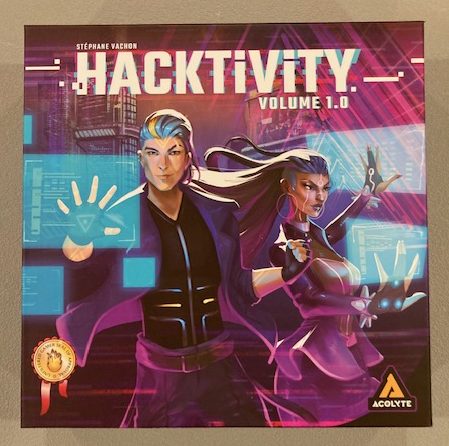
Hacktivity was a game on Kickstarter back in June 2022: see link here. This is a cooperative hand management game for 1-4 players. It originally promised delivery in February 2023, but didn’t deliver to my house until late April 2024: this makes it over a year late!
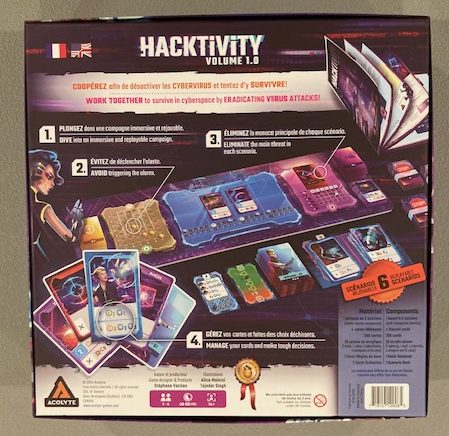
I was originally a little concerned about this game because at some point there was a Kickstarter update saying they lost their manufacturer! I was worried that this meant we might never see the game, but the Hacktivity people persevered and did deliver final copy! I was actually quite impressed with their positive attitude and communication during the Kickstarter! I’ve had a number of Kickstarters recently with poor communication and it was nice to see someone owning every step of the process!
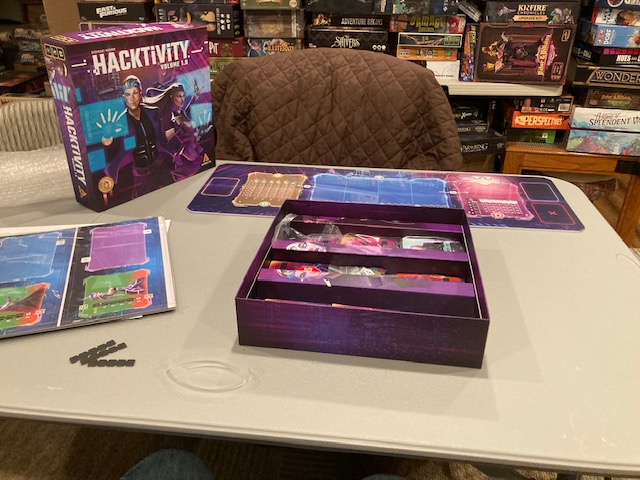
Let’s take a look!
Unboxing and Gameplay
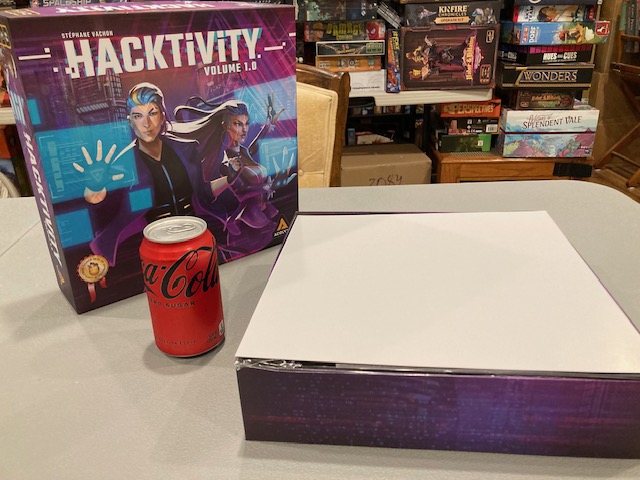
This is a fairly standard sized box (“about” the size of a Ticket to Ride sized box): see Coke can above for perspective.
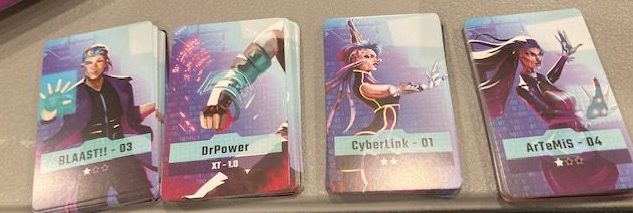
In this game, each player takes on the role of a special hacker. See the four decks above.
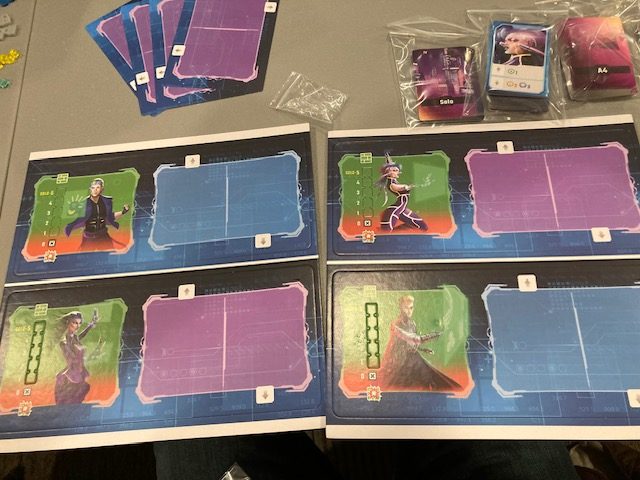
Each hacker has their own board as well: see the boards above.
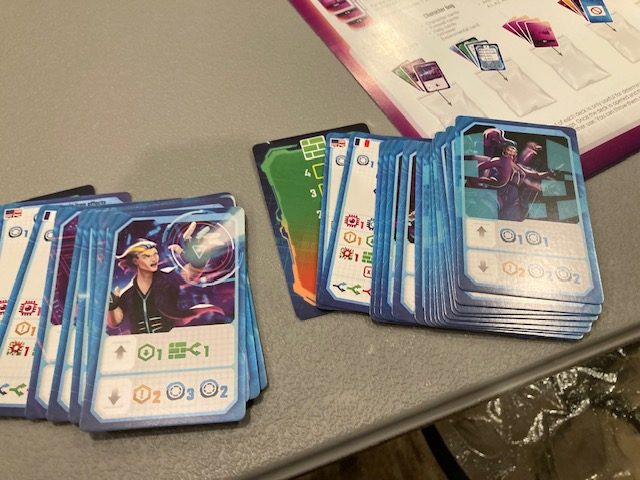
Each hacker’s deck is different and has a different emphasis or/and special powers. See two such decks above.
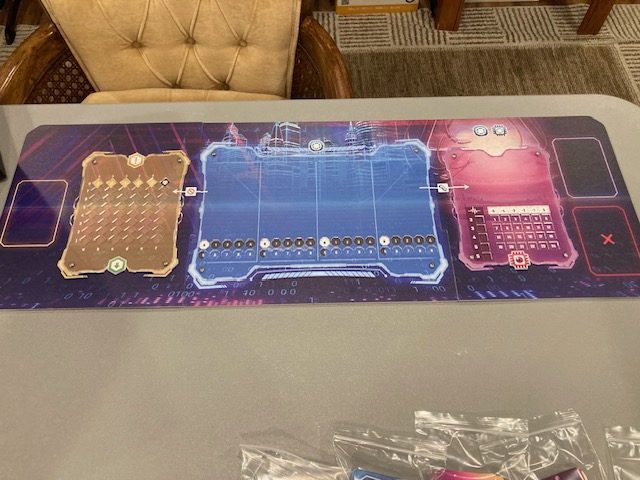
The players are interacting with a board (see above) with three separate regions. Notice how nice the plastic components of each region are!
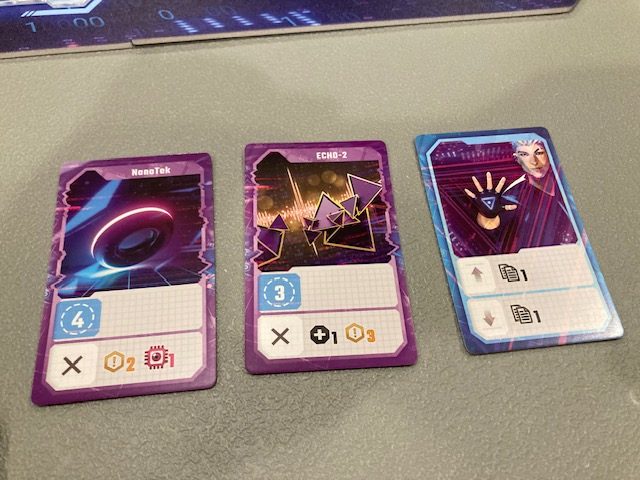
This is a game about managing cards. The purple cards are the virus cards that have bad effects … we’ll dub these the “bad news” cards. The blue cards are the player cards that keep the bad news (the viruses) under control. We’ll call the blue cards the “good news” cards. See above.
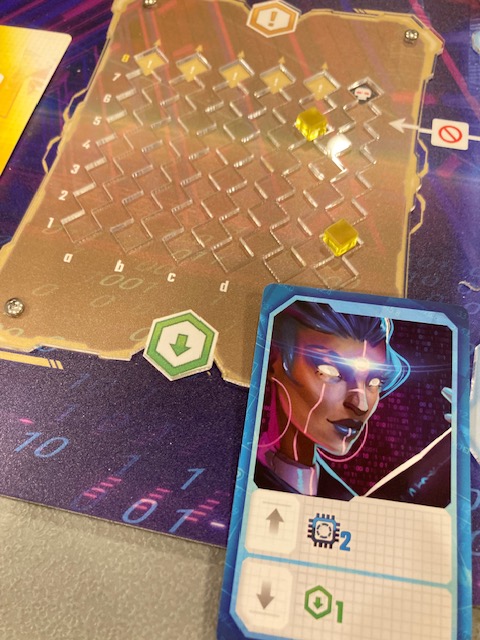
The leftmost board (yellow) keeps track of activity: you move the leftmost yellow cube up as a “bad news” as the games plays. If all yellow cubes make it to the top (see above), players lose!

The middle board (blue) is a place where you can “isolate” viruses that come out. This isolation defers their effects and makes you deal with them later.

The right-most red board keeps track of “the strange bug”: this is usually what you are trying to keep under control. In the first game, you need to keep the “strange bug” in the white area to win.

In order to win, players (usually) need to make it through all of the bad news cards (purple cards) and all of their own cards (blue) without losing! See above, a winning game! All bad news (purple cards) are in the discard! And “the strange bug” was kept under control in the white zone!

What’s interesting about this game is that every turn presents a lot of choices! The first choice: how many bad news (purple) cards do you take and how many good news (your character cards) do you take? See above as we choose two good news (ArTeMis) and one bad news (A1). You have to work your way all the way through both decks eventually, so you can’t always take more good than bad! You have to balance that out!
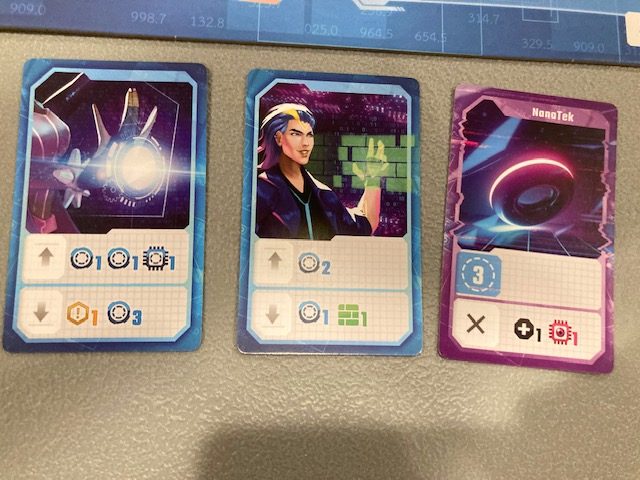
Once everyone chooses their cards, everybody flips and has to deal with their cards!

Every card offers one of two choices. For the bad news card above, you can choose the top or bottom: either isolate the virus on the blue board (notice the blue circle on the TOP CHOICE) with hope to destroy it later OR you can destroy it immediately, but pay the full cost on the bottom of the card.
But it’s a choice.
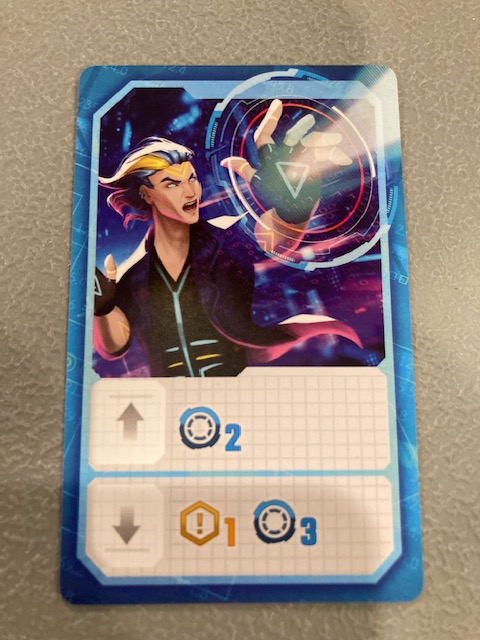
The good news cards (your player cards) are also a choice: the top choice is usually a lesser choice, but with no side effects. The bottom choice is usually more powerful, but with a bad side effect! On the card above, the upper choice is an attack of 2 on an isolated virus … but no side effect. The bottom choice is a more powerful attack of 3, but having the side effect of raising the activity (the yellow board).

Players continue to play until they meet the winning conditions! Usually, this means playing though all decks (bad news and good news decks) and keeping “the strange bug” under control!
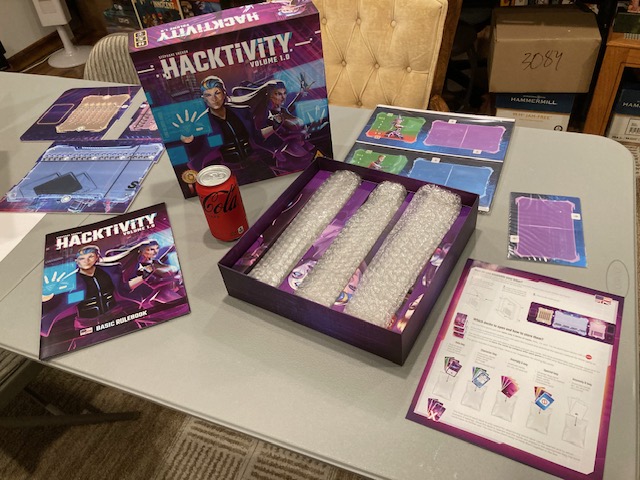
Given that the Kickstarter had to switch manufacturers halfway through, the game has really nice components! My only major complaint is that I wish the cards were linen-finished: you do handle the cards a lot as you play. But I liked the art and three-part board works well.

Rulebook

The rulebook is two-sided: one part is in French and the other in English! It’s much less daunting when you know it’s only 12 pages (with the other 12 pages being the French rules).
The game does pretty well on The Chair Test: The rulebook fits on the chair next to me pretty well. The rulebook is a little bigger than I wanted, but it still stays open. The font is a little thin and a little small, so it’s a little harder to read than it should, but it still works: this is about a B+ on The Chair Test.
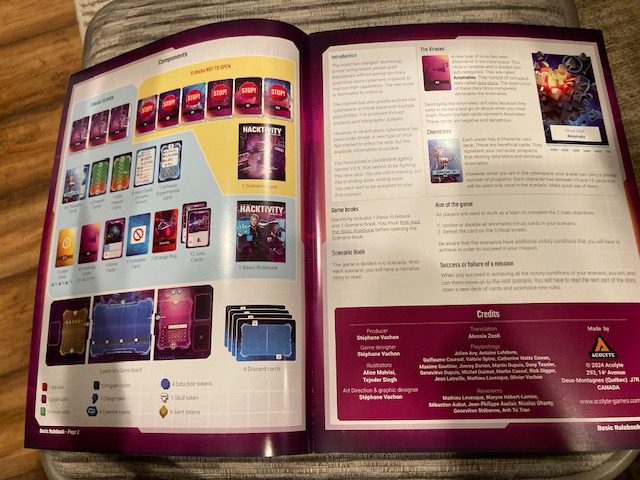
The components are well-labelled. See above.
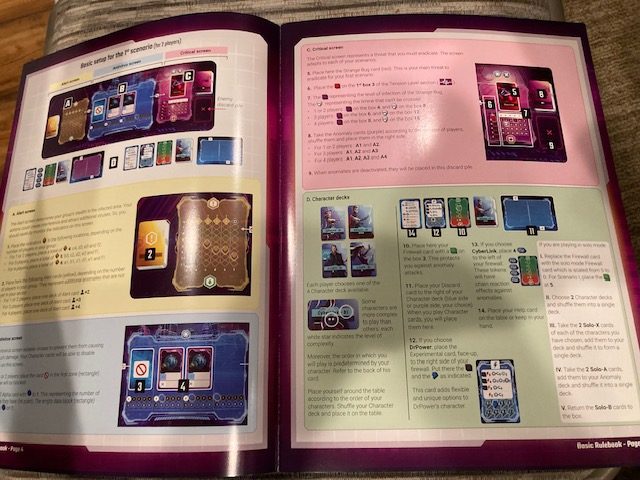
The Set-up (above) is pretty well documented: this set-up spans two opposite pages, so it’s easy to set-up by just leaving the rulebook open.

The rules are generally pretty good and well notated.
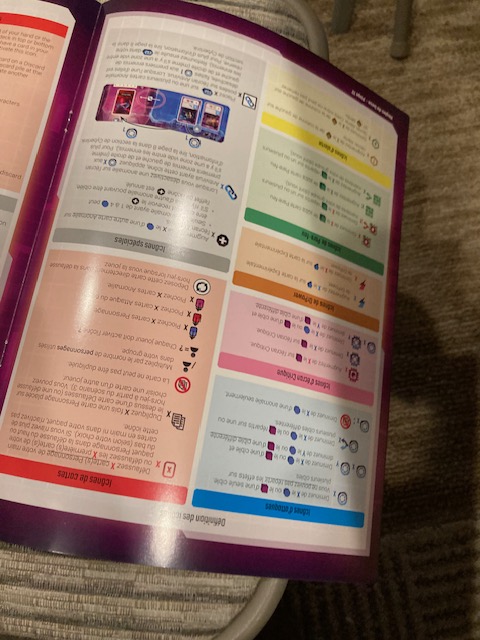
The biggest flaw is that there is no index (boo), but the last page of the book has a nice list of symbols.

I was happy with this rulebook. This rulebook was obviously a translation, but there were only a few places where that was readily apparent.
Solo Play

So, the game does have a nice solo mode (thanks for following Saunders’ Law)!

The solo game is NOT playing two characters: basically, you combine the decks of two characters (see above as I play BLASSST!!! and ArTeMis!) and just play that one deck (setting up the rest of the game as if it were a 2-Player game). I was worried about this solo mode at first … “Is this really different from the cooperative mode?” And it’s really not. You just have more cards to play through. I am surprised I like this solo mode: I usually prefer playing two separate characters with two positions (see Leviathan Wilds from a few weeks ago), but this combined-deck solo-mode worked for me.
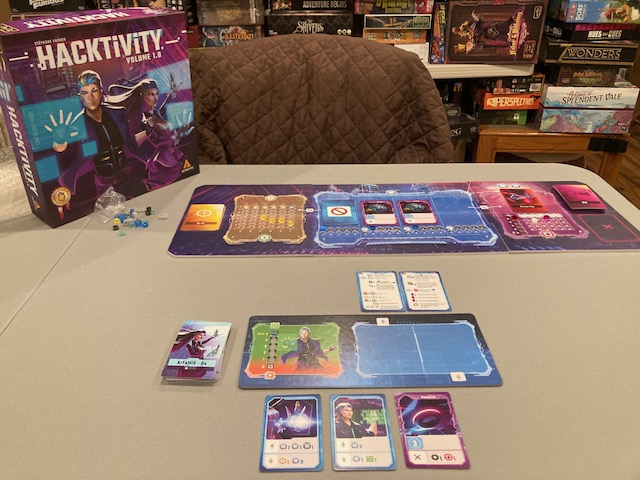
So, the solo game combines two decks and has the solo player become a “cyborg” of those characters (I am taking artistic license here). See above.

Interestingly, I played my first solo game when I got the game a while ago, but it took a while to interest my friends! So I had to remind myself how to play with a few more solo games right before I taught them how to play. I am happy to say that I enjoyed the solo mode more the more I played it. It’s only a 40-60 minute game! It moves quickly! And it was easy to remember how to set-up and play.
I liked Hacktivity solo and I liked the solo mode that came with it.
Cooperative Mode
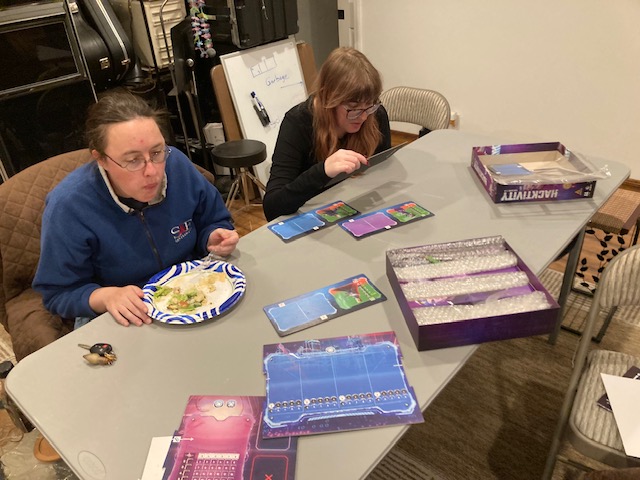
The cooperative mode was easy to teach. The basic flow of the game is pretty simple once you get the idea.
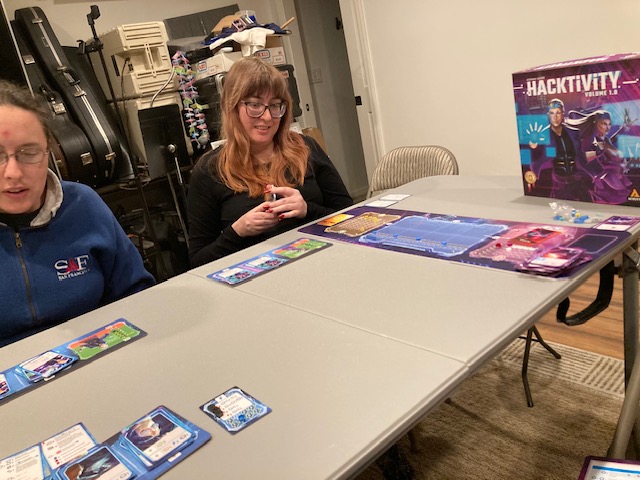
I think the least favorite aspect of the cooperative game were the limits on communication. Strictly speaking, you can’t say much about your hand: you can sort of hint about how much damage you can inflict, and you can hint at stuff. As we played, we kind of ended-up slowly moving around this restriction … because it wasn’t fun! We play cooperative game because we want to talk and interact with our friends: we usually dislike cooperative games with limits on communication.
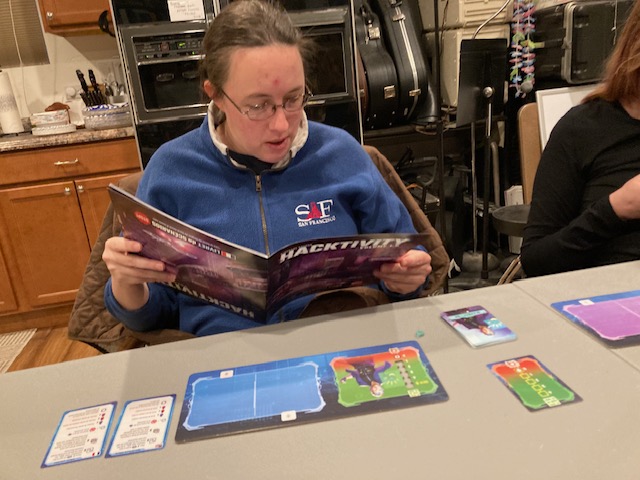
There are a lot of little icons in this game as well: that took a little to get our heads around, and the rulebook had to be passed around a little (see above). After a while, the icons took hold and we could just play: it didn’t take too long (and the little player aid cards helped a lot).
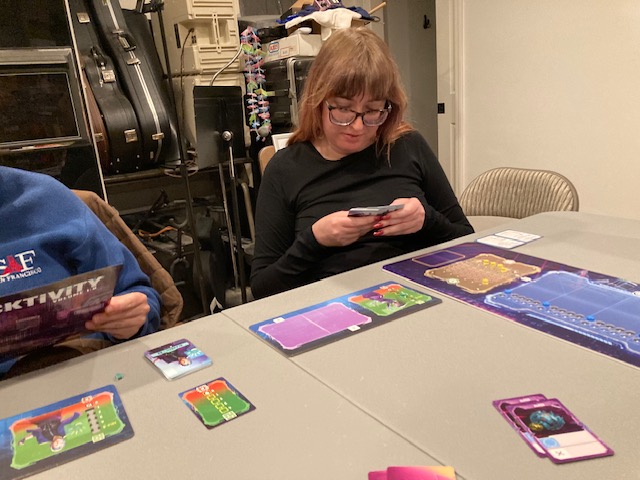
In general, the cooperative game went pretty well, but not great. The real issue was the limit on communication. And we get it: sometimes you need that restriction to keep the Alpha Player in check … but we ended up just going around the communication restrictions.
What I Liked

The color-coding scheme worked very well. The blue section of the board … gets affected by the blue markers. The yellow part of the board … is affected by the yellow icons. This was very clear and very well done. This color coordination really helped move the game forwards, as it appealed to your intuition (“this color goes here”).

The order in which you resolve your good news and bad news cards is players’ choice: You can even intersperse your card resolutions between players! You can do good news first, then bad news, or all at once! It’s players’ choice!! This is fine-grained Player Selected Turn Order at its finest!! This is where the cooperation shined (shone?) most in this game! As a group, we had to figure out the order to resolve cards, and we felt clever when we could avoid certain bad news effects by playing these certain orders! I really really liked how they used Player Selected Turn Order in Hacktivity! It really made the game feel that much more cooperative.
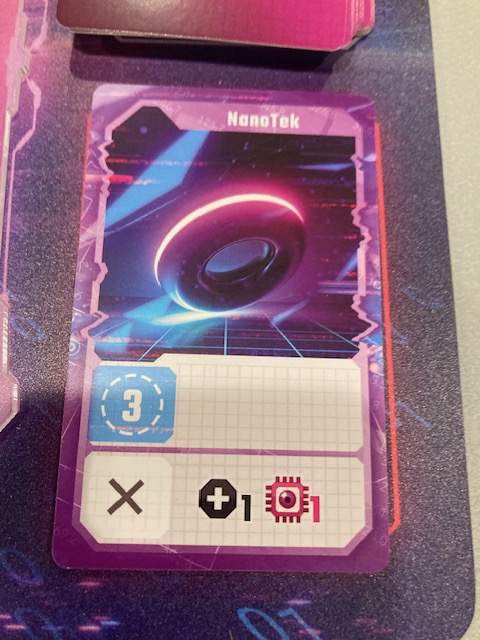
Every card is a choice! This is great! Every single cards has to be resolved, and you have a choice of whether to take the top or bottom option!
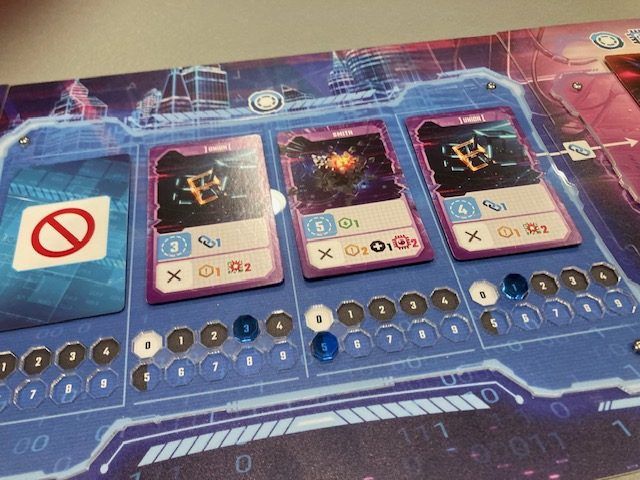
The game is easy to teach and play quickly. And it’s a pretty quick game at 40-60 minutes.

We didn’t get into it too much, but there is a campaign here if you want to pursue it.
What I Didn’t Like
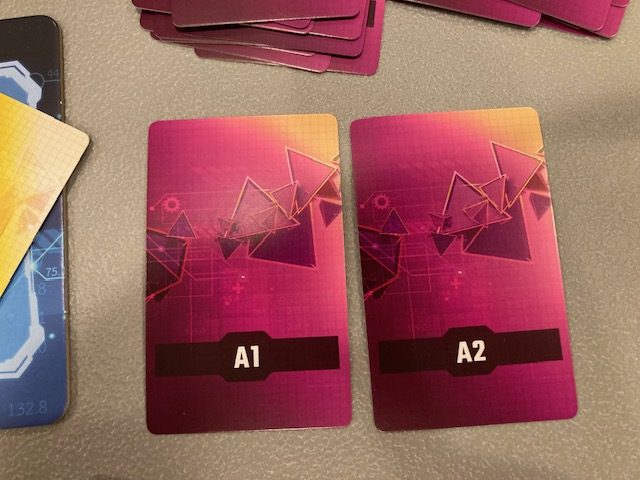
This is more of a missed opportunity than a dislke: the backs of the bad news card don’t mean anything (unless it’s a yellow activity card, which happens just a few times). See the A1 and A2 above? They mean nothing useful for gameplay: they only denote which player count decks you are using. Paleo did the wonderful thing (see our review here) of having the back of the cards be a “hint” as to what’s on the front of the card. The A1 and A2 on the backs of the cards above …. don’t really mean anything. They SHOULD give you a hint to “how hard” the bad news is, but they really don’t.
Since you are drawing bad news cards without knowing anything, it makes the game feel a little more random. How many Bad News cards should I draw? I don’t know … I don’t hav a sense of how hard each one is!!! I think a “hint” of some kind would make the game feel less random.

The limited communication rules felt too constraining; they hampered our enjoyment of the game. The best combinations we played in the game where when we could keep the bad news cards from having any effect … and we could only do this if we were more sharing. This game needs an Open Hand rule:
“If you and your friends are comfortable with Open Hand, go ahead and play with all cards showing. Realize that Open Handed may make the game easier, invite analysis paralysis, and/or cause Alpha Players to take over the game.”
Really, this communication limit drop probably dropped by friend’s rating of the game: see below.
Conclusion

I liked Hacktivity! I enjoyed all the choices in the game: choosing how many good news/bad news cards to choose, the order to resolve the cards (fine-grained Player Selected Turn Order), and the choices per card! All of this really made me feel like I was making choices that mattered as I played.

I was be remiss if I didn’t include my friend’s opinions: I liked this more than them. I would give this a 7/10, and suggest we play Open Hand. My friend Teresa liked it ok (no rating), but Sara said “I would give it a 4/10: I liked it okay, but there’s a lot better games to play!” I don’t necessarily agree with her, but you may feel as she does. The main issues for Sara were the lack of Hints on the back of the bad new cards and the stifling of cooperation. The limited communication can be counteracted by playing Open Hand, but the lack of hints can make the bad news feel too random and I am not sure what we can do about that.

I would be happy to teach this to you: I think Hacktivity is a quick and easy game to teach/learn and it promotes a lot of choice. The solo game was fun and the cooperative game was fun once we added Open Hand.
2 thoughts on “Cooperative Hacking: A Review of Hacktivity”